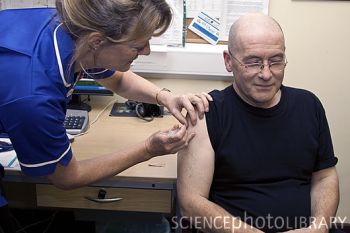研究结果显示,接种季节性流感疫苗的成年人成功防止流感的几率只有59%,这不足以在流感大暴发时使人们得到保护。这一研究或许有助于人们加速进行疫苗改良工作。

该研究报告的作者、明尼苏达大学的迈克尔·奥斯特霍尔姆说:“今天的流感疫苗就像iPhone1,而我们需要的是iPhone10。”
根据以前的研究,H1N1疫苗略强于季节性流感疫苗,在65岁以下成年人中防止感染的几率达到69%。鼻喷入法的效果更好,防止感染的几率在7岁以下的儿童中达到83%。该研究结果发表在今天的网络版《柳叶刀—传染病》杂志上。
奥斯特霍尔姆说,新发现不应打击人们接种疫苗的积极性,“我们知道我们需要更好的疫苗,但59%的保护仍比什么保护都没有更好。我仍建议人们接种疫苗”。
范德比尔特大学医学院的威廉·沙夫纳教授说:“流感疫苗无疑是很好的疫苗,但它并不是像小儿麻痹症疫苗、麻疹疫苗那样的优质疫苗,甚至在最有效的情况下,它都无法完全杜绝感染。”
相比之下,接种两次麻疹疫苗能预防约95%的感染,而小儿麻痹症疫苗除在少数几个国家外能完全根除小儿麻痹症。
密歇根大学公共卫生学院教授阿诺德·蒙托说,自上世纪40年代以来,制造流感疫苗的技术没有改变多少,“它在效力和安全方面有所提高,但基本原则是一样的”。
保护人们免受流感折磨是一项挑战。大多数死于流感的人都是老人。奥斯特霍尔姆说,给老人接种流感疫苗并不能阻止所有的死亡病例,因为免疫系统会随着年龄的增长受损,而且疫苗在老年人体内的效果就是不太好。一些研究表明,阻止流感传播的最有效途径是给小儿接种疫苗,他们对疫苗会作出更好的免疫反应。
科学家目前正致力于“全球流感疫苗”的研制,这项工作将持续数年。美国国家卫生研究院院长弗朗西斯·柯林斯说,在今后5年内有可能研制出这样的疫苗。
【《今日美国报》10月25日报道】与超重或肥胖相关的各类健康风险已是众所周知,但现在最新研究表明,额外体重还会使你每年接种的流感疫苗不太有效。
流感疫苗通过使接种者体内产生抗体发挥作用。根据10月25日刊登在《国际肥胖症杂志》网站上的研究结果,肥胖者、超重者和体重正常者在接种疫苗后的一个月内都产生了对付流感病毒的抗体,但肥胖者和超重者血液内抗体的消退速度更快。
研究人员发现,半数肥胖者在接种疫苗11个月后抗体减少的速度是接种疫苗1个月后的4倍。而只有不到25%的体重正常者在11个月后抗体减少的速度达到了这一程度。
此外,肥胖和超重者血液内被称为CD8+T的白细胞不能正常发挥作用,这种细胞在人体最重要的免疫系统内发挥着关键作用。当疫苗不能阻止流感时,人们必须在一定程度上依赖这些白细胞来限制受感染的速度和严重程度。(生物探索)
相关英文论文摘要:
Efficacy and effectiveness of influenza vaccines: a systematic review and meta-analysis
Background
No published meta-analyses have assessed efficacy and effectiveness of licensed influenza vaccines in the USA with sensitive and highly specific diagnostic tests to confirm influenza.
Methods
We searched Medline for randomised controlled trials assessing a relative reduction in influenza risk of all circulating influenza viruses during individual seasons after vaccination (efficacy) and observational studies meeting inclusion criteria (effectiveness). Eligible articles were published between Jan 1, 1967, and Feb 15, 2011, and used RT-PCR or culture for confirmation of influenza. We excluded some studies on the basis of study design and vaccine characteristics. We estimated random-effects pooled efficacy for trivalent inactivated vaccine (TIV) and live attenuated influenza vaccine (LAIV) when data were available for statistical analysis (eg, at least three studies that assessed comparable age groups).
Findings
We screened 5707 articles and identified 31 eligible studies (17 randomised controlled trials and 14 observational studies). Efficacy of TIV was shown in eight (67%) of the 12 seasons analysed in ten randomised controlled trials (pooled efficacy 59% [95% CI 51—67] in adults aged 18—65 years). No such trials met inclusion criteria for children aged 2—17 years or adults aged 65 years or older. Efficacy of LAIV was shown in nine (75%) of the 12 seasons analysed in ten randomised controlled trials (pooled efficacy 83% [69—91]) in children aged 6 months to 7 years. No such trials met inclusion criteria for children aged 8—17 years. Vaccine effectiveness was variable for seasonal influenza: six (35%) of 17 analyses in nine studies showed significant protection against medically attended influenza in the outpatient or inpatient setting. Median monovalent pandemic H1N1 vaccine effectiveness in five observational studies was 69% (range 60—93).
Interpretation
Influenza vaccines can provide moderate protection against virologically confirmed influenza, but such protection is greatly reduced or absent in some seasons. Evidence for protection in adults aged 65 years or older is lacking. LAIVs consistently show highest efficacy in young children (aged 6 months to 7 years). New vaccines with improved clinical efficacy and effectiveness are needed to further reduce influenza-related morbidity and mortality.
英文论文链接:https://www.thelancet.com/journals/laninf/article/PIIS1473-3099(11)70295-X/abstract







